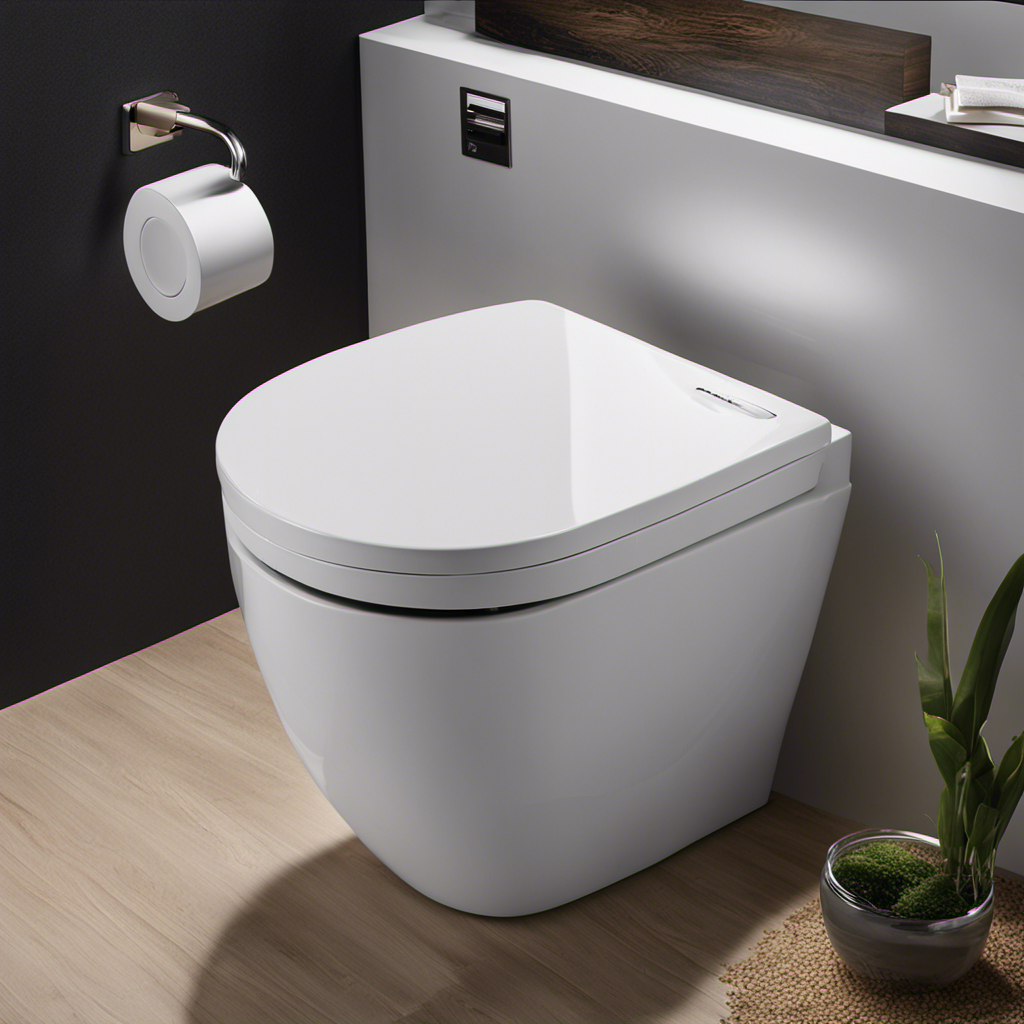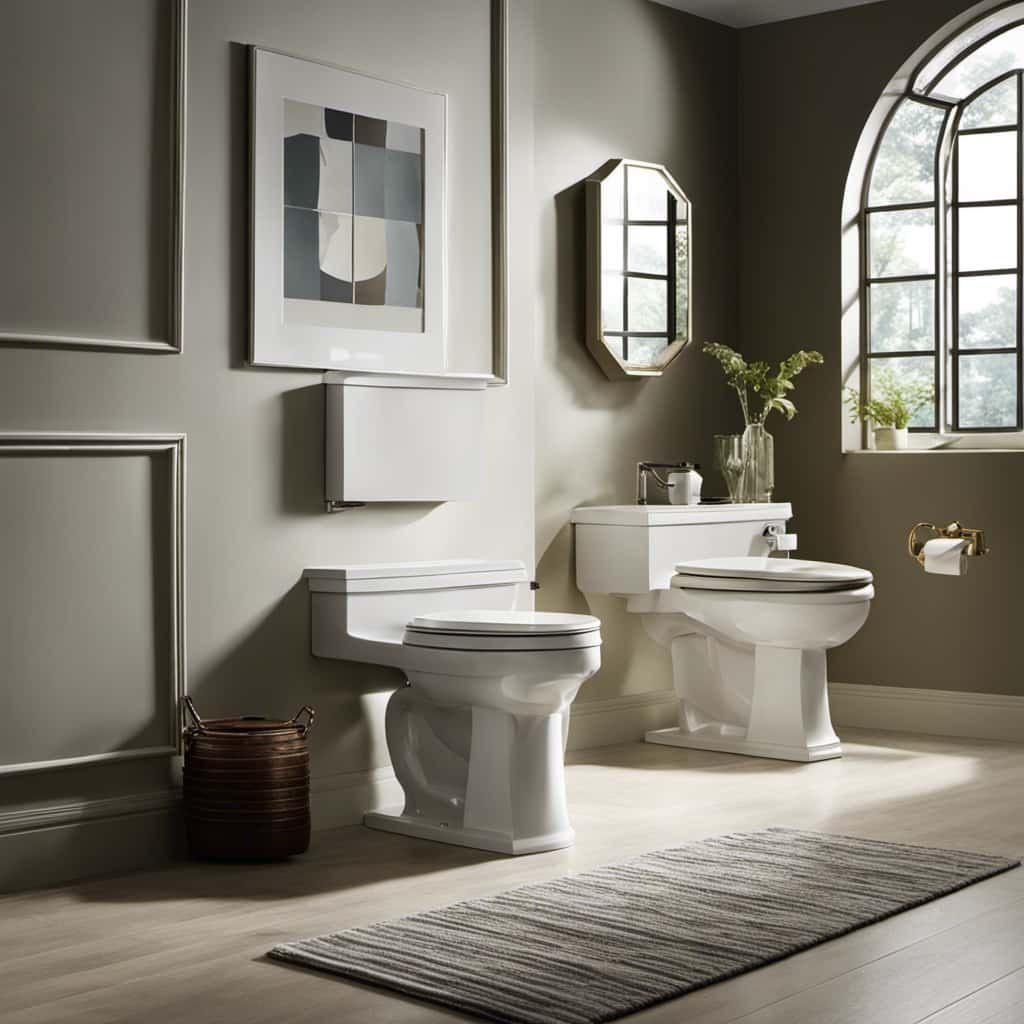I’ve always been curious about how much water it takes to flush a toilet. So, I decided to dig into the facts and figures to find out.
In this article, I’ll explore the water efficiency standards for toilets, the average water consumption per flush, and the factors that affect water usage in toilets.
We’ll also dive into the world of water-saving technologies for flushing and share some tips on how to reduce water usage in toilets.
Let’s get started and flush out the details!
Key Takeaways
- Water efficiency standards and toilet design innovations have been implemented to reduce water usage per flush and address the impact of water scarcity.
- Average water consumption per flush varies based on the age and type of the toilet, with newer models designed to be more water-efficient.
- Factors such as water pressure and the efficiency of flushing systems can affect water usage in toilets.
- Water-saving technologies such as low-flow toilets, dual-flush options, and pressure-assisted flushing systems can significantly reduce water consumption in toilets.
Water Efficiency Standards for Toilets
Water efficiency standards for toilets have been implemented to reduce the amount of water used per flush. These standards were put in place to address the impact of water scarcity and promote sustainable water usage.
Toilet design innovations have played a crucial role in achieving water efficiency goals. Traditional toilets typically used around 3.5 to 7 gallons of water per flush, but with advancements in technology, modern toilets now use only 1.6 gallons or even less. This significant reduction in water consumption has led to substantial water savings on a global scale.
For instance, if a household switches to a water-efficient toilet, it can save up to 13,000 gallons of water per year. These water efficiency standards, combined with toilet design innovations, are essential steps towards conserving water resources and ensuring a sustainable future.
Average Water Consumption per Flush
When you flush, you typically use around 1.6 to 3 gallons of water. Toilet water usage, also known as toilet flush volume, can vary depending on the age and type of toilet you have. Older toilets tend to use more water per flush, while newer models are designed to be more water-efficient. To give you an idea of the average water consumption per flush, take a look at the table below:
| Toilet Type | Average Flush Volume (gallons) |
|---|---|
| Standard | 1.6 |
| Low-flow | 1.28 |
| Dual-flush | 0.8/1.6 |
| High-efficiency | 0.8/1.0 |
| Waterless | 0 (no water used) |
As you can see, the newer toilet models, such as low-flow, dual-flush, and high-efficiency toilets, are designed to use less water per flush compared to standard toilets. This helps conserve water and reduce overall water consumption in households and commercial buildings. So, if you’re looking to save water and reduce your environmental impact, consider upgrading to a more water-efficient toilet.
Factors Affecting Water Usage in Toilets
If you’re thinking about upgrading your toilet, it’s important to consider the factors that can affect water usage.
Two key factors that can impact water usage in toilets are water pressure and toilet design.
Water pressure plays a crucial role in determining the efficiency of a toilet’s flushing mechanism. Higher water pressure can help ensure a more powerful flush, reducing the need for multiple flushes and ultimately conserving water.
On the other hand, toilets with poor design or outdated technology may require more water to effectively remove waste, leading to unnecessary water wastage.
Therefore, when choosing a new toilet, it is important to look for models that have efficient flushing systems and consider the water pressure in your home to maximize water conservation.
Water-Saving Technologies for Flushing
Using water-saving technologies in toilets can significantly reduce water consumption. With the increasing impact of water scarcity, it is essential to adopt innovative solutions that minimize water wastage. One such solution is the installation of low-flow toilets, which use less water per flush compared to traditional toilets. These toilets have a range of water-saving features, such as dual-flush options and pressure-assisted flushing systems.
To highlight the impact of water-saving technologies, consider the following table:
| Technology | Water Savings |
|---|---|
| Dual-flush toilets | Up to 50% |
| Pressure-assisted toilets | Up to 25% |
| Smart toilets | Up to 20% |
As shown in the table, water-saving technologies can reduce water consumption by significant percentages. By implementing these innovations, we can conserve water resources and contribute to a more sustainable future. It is crucial for individuals, businesses, and governments to embrace these advancements and play their part in addressing the global water crisis.
Tips for Reducing Water Usage in Toilets
One effective way to reduce water usage in toilets is by installing a dual-flush system. This innovative system allows users to choose between a partial flush for liquid waste and a full flush for solid waste, significantly reducing overall water consumption.
Here are some toilet water-saving hacks to further reduce water usage:
- Adjust the float valve: Lowering the float valve in the toilet tank can reduce the amount of water used for each flush.
- Install a toilet tank bank: Placing a tank bank or a sealed plastic bag filled with water in the toilet tank can displace water and reduce the volume used per flush.
- Fix leaks promptly: A leaking toilet can waste hundreds of gallons of water per day, so it’s crucial to fix any leaks as soon as possible.
The benefits of dual flush toilets include saving up to 50% more water compared to traditional toilets, which can amount to significant cost savings and reduced environmental impact.
Conclusion
In conclusion, it is mind-blowing to realize just how much water it takes to flush a toilet. With water efficiency standards in place, toilets now consume an average of 1.6 gallons of water per flush.
However, various factors can affect water usage, such as toilet design and maintenance. Thankfully, water-saving technologies have emerged, allowing us to reduce water consumption even further.
By implementing these technologies and following simple tips, we can make a significant impact in conserving water and preserving our precious resources.
Let’s flush away excessive water usage and embrace a more sustainable future!










